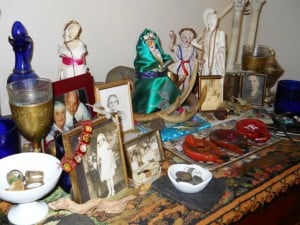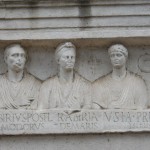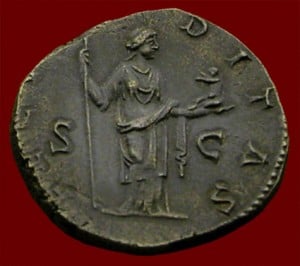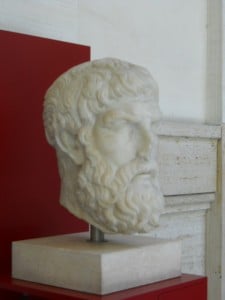Each spring the cosmopolitan city of ancient Rome witnessed the cannophori of Attys streaming from the City on the Ides of March. They went in search of his sacred pine. As they did so, they would wave strands of palms high in the air. This Procession of the Palms by the cannophori, or “tree-bearers,” went into the nearby hills to gather pines. Smaller pines would be brought into individual homes. Initially these were left undecorated, but later in the festival, with the Resurrection of Attys, the pine trees would be decorated with red candles, fruits, and images of the Gods. But the ultimate quest of the procession in March was to find the tallest pine, a phallic symbol, which would represent Attys himself, for the myths told how he had died beneath a pine tree. The discovered pine was carried back to the City; it was buried in a tomb in the Forum, mourned for the death of Attys, and then, on the third day, it was raised from its tomb, victorious over death at the beginning of spring, in the joyous celebration of the Hilaria. This was the true origin of the Holiday Tree we see today in December. The pine represents the birth of a Savior who shall die and resurrect in spring just as Attys was once celebrated. Christmas, coming around the winter solstice, is linked to the celebration of Easter, which comes just after the spring equinox. In the same way, the ancient rites of resurrecting a sacred pine tree of Attys in spring linked back to the Mesonyctium, or Vigil of Attys, which is celebrated on 9 December.
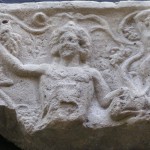
Ancient Rome was familiar with more than one such foreign God as Attys. Arriving from the Eastern provinces, there was something like twenty-two dying gods who would resurrect from death and rise into the heavens. None of the dying and resurrecting Gods, however, is more closely associated with the modern holiday season than is Adonis. In the most ancient civilizations of Mesopotamia – Sumer, Babylon, Assyria – he was called Dummuz, the Good Shepherd, who became the mortal lover of Ishtar. In Syria and Judea Dummuz was known as Tammuz, the mortal lover of Astarte. The Judeans called him “Lord,” Adonai in Aramaic, from which the Greeks called him Adonis. The Greek myth made Adonis the son of the virgin Myrrha and, after Inanna of Sumer, Akkadian Ishtar, and Syrian Astarte, he became the mortal lover of another Goddess of Love, Aphrodite. The Romans adopted his Greek name and had Adonis as the lover of both Venus and Proserpina. For part of the year Adonis would spend a carefree life with Venus, and for part of the year he descended back down to Hades to be with Proserpina. Thus, like Proserpina herself, Adonis represented the changing seasons. The Romans knew Adonis also as Pales, from which Palestine received its name. Pales, another of the dying and resurrecting gods, came from North Africa where he is sometimes depicted as a man with the head of an ass who is crucified on a solar cross. All of the dying gods were in one way or another related to the solar cycle, and a cross accompanied them as it represented the solar cycle divided into four seasons by the solstices and equinoxes. In the allegorical myths, Orpheus, Hercules, Pales and others died on a cross. Adonis Tammuz, like Attys, died beneath a tree:

“Venus, neglecting heaven, prefers Adonis . . . She cheers the hounds, intent to hunt for harmless prey, such as the leaping hare, or the wild stag, high-crowned with branching antlers, or the doe. . . . She warns you, Adonis, to beware and fear them. If Her fears for you were only heeded! ‘Oh be brave,’ She says, ‘against those timid animals which fly from you; but courage is not safe against the bold. Dear boy, do not be rash, do not attack the wild beasts which are armed by nature, lest your glory may cost me great sorrow. Neither youth nor beauty nor the deeds which have moved Venus have effect on lions, bristling boars, and on the eyes and tempers of wild beasts. Boars have the force of lightning in their curved tusks, and the rage of tawny lions is unlimited. I fear and hate them all’ . . .
“but his rash courage would not heed advice. By chance his dogs, which followed a sure track, aroused a wild boar from his hiding place; and, as he rushed out from his forest lair, Adonis pierced him with a glancing stroke. Infuriate, the fierce boar’s curved snout first struck the spear-shaft from his bleeding side; and, while the trembling youth was seeking where to find a safe retreat, the savage beast raced after him, until at last he sank his deadly tusk deep in Adonis’ groin; and stretched him dying on the yellow sand (Ovid, Metamorphoses 10. 834; 1118-1129).”
At the summer solstice, the death of Adonis was bewailed before the northern entrance of the temples of Jerusalem and Antioch (Ezek. 8:14-15). This is due to the fact that the sun reaches its northern-most point on the eastern horizon as it dawns on the summer solstice. The marriage of Adonis to Venus was celebrated the day before the solstice, then his death was mourned the following day, before his rebirth and resurrection was celebrated once more. The approach of the festivals of Adonis came with the reappearance of the planet Venus as it changed between an evening star and a morning star and back once more. Thus, the planet Venus was known among worshipers for Adonis as the “Star of Salvation appearing in the East” (Ammianus 22.9.14). The most sacred site of Adonis throughout the region was a grove in the garden at Bethlehem where Adonis was said to have been born.
“Bethlehem, now ours,” wrote Jerome, “and the earth’s most sacred spot . . . was overshadowed by a grove of Thammuz, which is Adonis, and in the cave where the infant Messiah once cried, the paramour of Astarte (Venus) was bewailed (Epist. 58.3).” Contrary to what Jerome of Bethlehem and Paulinus of Nola (Epist. 31.3) thought, the sacred grove and its grotto had been held as the birthplace of Adonis for millennium in Bethlehem, the “House of the Goddess,” long before Jesus was confused with Adonis. Emperor Hadrian appears to have restored the grove, but later, under the Christian emperor Justinian, the sacred trees of the grove were cut down and the stones of the grotto quarried for the Church of the Nativity. According to Jerome, too, when Adonis died at the summer solstice, Venus fled to the Garden of Gethsemane at the foot of the Mount of Olives outside Jerusalem, mourning Her loss of Adonis. As the myth was inscribed in Assyria:
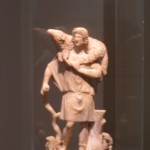
“She can make the lament for you, my Dumuzid, the lament for you, the lament, the lamentation, reach the desert — She can make it reach the house Arali; She can make it reach Bad-tibira; She can make it reach Dul-šuba; She can make it reach the shepherding country, the sheepfold of Dumuzid. ‘O Dumuzid of the fair-spoken mouth, of the ever kind eyes,’ She sobs tearfully, ‘O you of the fair-spoken mouth, of the ever kind eyes,” She sobs tearfully. “Lad, husband, lord, sweet as the date, . . . O Dumuzid!’ She sobs, She sobs tearfully (Nippur tablet 4486).”
Lucian of Samosata wrote about the Levantine Astarte, calling Her the Dea Syria, and told us something about the connection made with Adonis at Her temple in Byblos.
“I saw too at Byblos a large temple, sacred to Aphrodite of Byblos [Astarte]: this is the scene of the secret rites of Adonis: I mastered these. They assert that the legend about Adonis and the wild boar is true, and that the facts occurred in their country, and in memory of this calamity they beat their breasts and wail every year, and perform their secret ritual amid signs of mourning through the whole countryside. When they have finished their mourning and wailing, they sacrifice in the first place to Adonis, as to one who has departed this life: after this they allege that he is alive again, and exhibit his effigy to the sky.”
“There is, too, another marvelous portent in the region of Byblos. A river, flowing from Mount Libanus, discharges itself into the sea: this river bears the name of Adonis. Every year regularly it is tinged with blood, and loses its proper color before it falls into the sea: it dyes the sea, to a large space, red: and thus announces their time of mourning to the Byblians. Their story is that during these days Adonis is wounded and that the river’s nature is changed by the blood which flows into its waters; and that it takes its name from this blood(Lucian, Deae Syriae 6; 8).”
Although Venus flew down to kneel beside Adonis, She was unable to save his mortal life. The shepherd, born from a myrrh tree, died pinned to another tree. Venus first offered funeral rites for Adonis. Then, spreading nectar over his blood:
“when from Adonis, blood, exactly of its color, a beloved flower (the red anemone) sprang up, such as pomegranates give to us, small trees which later hide their seeds beneath a tough rind. But the joy it gives to man is short-lived, for the winds which give the flower its name, Anemone, shake it right down, because its slender hold, always so weak, lets it fall to the ground from its frail stem(Ovid, Metamorphoses 10. 1155-1163).”
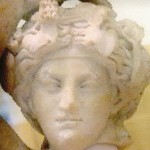
The death of Adonis was not the end of the story. Venus sought to resurrect Adonis and the council of the Gods agreed to allowed this. But by the time Venus went to collect Adonis from the land of the Dead, Proserpina had already fallen in love with the beautiful youth, and thus was reluctant to let Adonis leave. Jupiter eventually had both Goddesses concede to a compromise whereby Adonis would spend half the year with Proserpina from summer solstice to winter solstice. Then at winter solstice he would be reborn into life once more. The original Dummuz, dying and resurrecting when he did, was a seasonal God. Like Osiris who regularly died and rose again, there was a vegetative aspect to the seasonal changes represented by Adonis. The worship of Adonis retained this vegetative aspect in that mourners would plant seeds in pots at summer solstice, allowing them to quickly sprout, and then placed these in little boats to sail down river as they quickly wilted in the summer heat. The Greeks identified the God of Israel as Dionysius due to the ubiquitous cult of Adonis throughout Judea and his association with the Jewish Temple of Jerusalem. The ancient deities of the East were seasonal and vegetative. In the Hellenist era some were developed further in mystery religions. Greek Adonis had taken on other aspects, with his annual birth, death, and resurrection representing a spiritual renewal of his followers. In this he was much like other foreign gods and goddesses of the mystery religions – Persephone, Serapis, Orpheus, Attys, Pales, Heracles, Osiris, Mithras, Toumou, Kore, Anhouri, and Dionysus, to name a few of the dying and resurrecting gods and goddess. The Greeks and Romans alike saw their myths and rituals as allegories that apply to all men and women. Everyone is a child of the Gods, a divine spirit descended into the material universe, subject to change in the cycle of life, but with the promise that, once released from the tomb of the material body, they shall ascend once more into the heavens to sit beside the Gods. Celebrated then was the Good Shepherd Adonis, born to a virgin in a sacred grotto in Bethlehem at winter solstice, 25 December, who brought hope for the New Year, and hope for his followers, too, of being born again into a new life after death.


